Comparison of Vutlan SC8100 and APC NetBotz Rack Monitor 200 monitoring systems
In the life cycle of any enterprise there comes a period when the complexity or amount of equipment exceeds the capabilities of the attendants. And if with 2-3 servers, 1 air conditioner or 1 power distribution cabinet, the engineer can keep all the data in his head and constantly monitor the device parameters, then with dozens or even hundreds of pieces of equipment, the monitoring system for parameters pays off and becomes a necessary part of the infrastructure. Most often, the monitoring module is used in the IT field to monitor the parameters of the data center: temperature, humidity, equipment condition, power supply parameters, leakage and the absence of fire. Sometimes there are non-standard solutions for the use of monitoring systems to track equipment parameters: air conditioners, RS, SSU cabinets, machine tools, telematics objects, smart home. Compare the two monitoring systems of the APC NetBotz 200 and Vutlan SC8100 parameters.
Comparison will hold in 3 categories:
In the first case, consider the main differences in the characteristics. We will only compare the parameters, differences in which affect the ease of installation or operation of the system. In the same paragraph, we consider the possibility of scaling the system: the number of ports for sensors in both monitoring systems, the differences and the variety of sensors. In the second case, we consider the software capabilities of the parameters monitoring systems. Collecting information from sensors is a third of the task. The main thing is to notify the staff when the parameters go beyond the limits of the norm, and ideally - to predict the dynamics of changes in parameters, and not to allow the parameters to go beyond the limits of the norm. In the third case, we compare prices for a typical set of modules and sensors of monitoring systems.
And now some text and pictures.
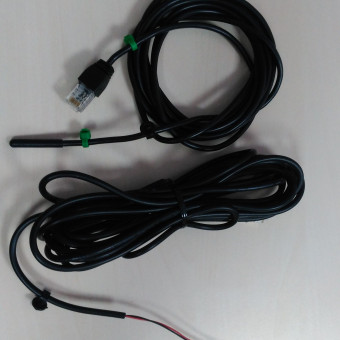

I will immediately answer the question why I am paying such attention to installation, sensors and connectors. Almost always, the sensors are removed from the monitoring system at a distance greater than the length of the standard patch cord from the kit. In the diagram, a temperature sensor is connected to the A1 Vutlan SC8100 port, which is located in the same rack. But all the other sensors (ports A2-A6) are located in the next room.

For this, we had to use a standard patch panel, and inexpensive office boxes for cable termination. When connecting the APC Netbotz Rack Monitor 200 to the patch panels, the most common RJ-45 patch cords (1 pc) are used. And the sensors are simply included in the office box. In the case of the Vutlan monitoring system sensors, you will have to worry about finding a rare and non-standard patch cord: 6P4C with direct crimp.

Externally, it looks like a four-wire RJ-11 cable for connecting a telephone device. But the standard cable has a cross-crimp, and the cable for connecting the sensors is straight, because of this, using a standard RJ-11 cable to connect the sensor will not work. And you need to “strongly in advance” to order the right ones, or by purchasing the 6P6C connectors to crimp the cables yourself. Dry contact modules in monitoring systems are implemented in a different way. In the Vutlan system, dry contacts are installed in the system with a separate module, with PCB connectors.
In the APC system, dry contacts are represented by a sensor plugged into a standard port.

With a small amount (1-2) of the output of dry contacts, the solutions are equivalent, with a large number of dry contacts, the monitoring system from Vutlan wins. An important, and maybe for someone, decisive selection criterion will be the variety of sensors connected to the parameter monitoring system. The monitoring system from Vutlan has a wider choice of sensors: analog sensors , digital sensors , current and voltage sensors and a whole section “ accessories ”. A good example is the VT491 bulk temperature sensor or the VT11 controlled dry contact sensor. You will not find such sensors in the APC Netbotz range. But, are they really necessary, because the VT11 is easily replaced by a relay output, and the room temperature is considered to be CDEF functions? Mankind, for two thousand years, has invented a huge number of sensors: pressure, movement, acidity, density - in general, any physical quantities. And, using a 4-20 mA current sensor or a dc voltage sensor, you can integrate any third-party analog sensor into a monitoring system. Using dry contacts and relays, you can integrate any discrete sensor.
Both the one and the second module of the monitoring system perform their main function: the aggregation of sensor readings, and the display of values using the Web or SNMP protocol:


Both in one and in the second module there is an opportunity to set the limits of values, and a notification about the values leaving the limits of the norm:


All additional, not basic functions are present in both monitoring systems: ftp backup, RADUIS authentication, ntp client, syslog client, sensor graphics:


For the curious, screenshots of the APC Netbotz Rack Monitor 200 and vutlan SC8100 web interfaces can be viewed here.


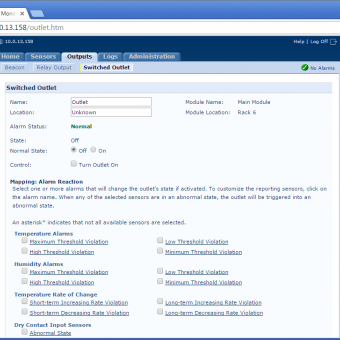
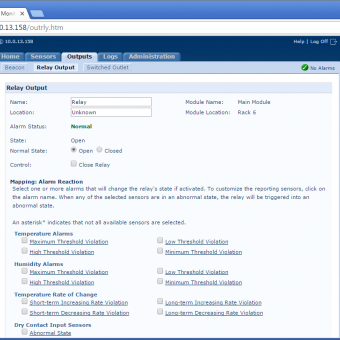
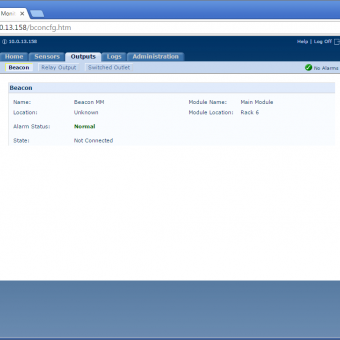


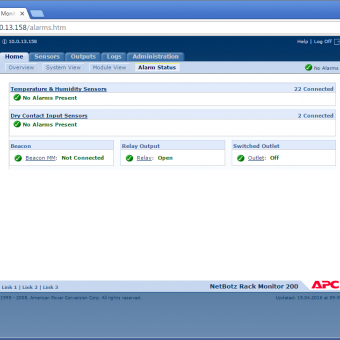

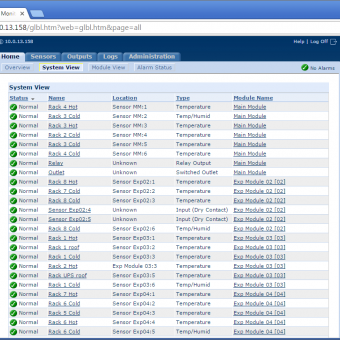


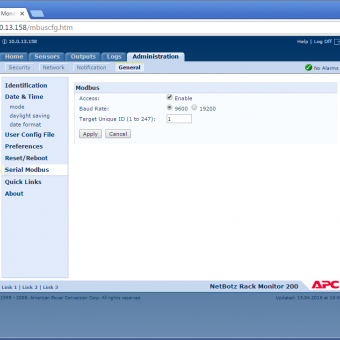
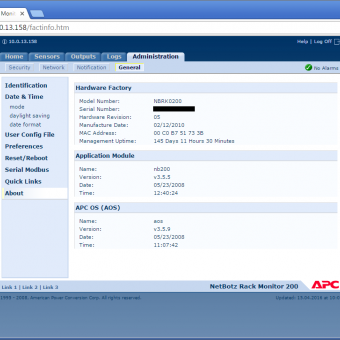










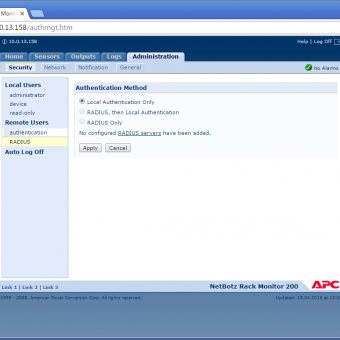
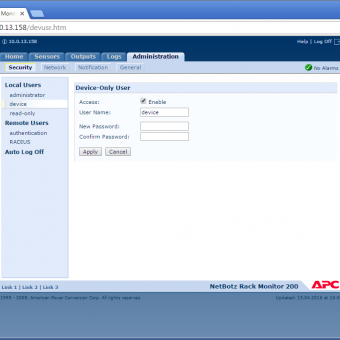
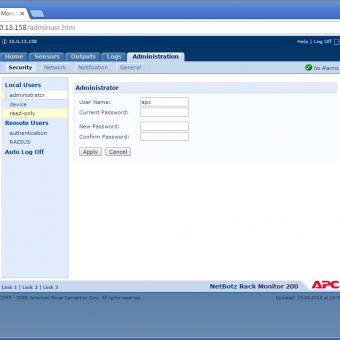
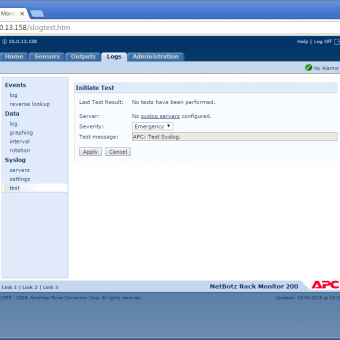
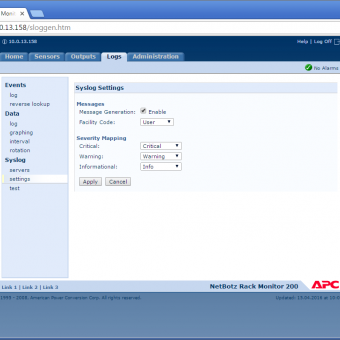




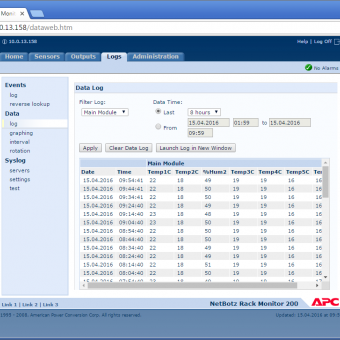
At http://www.telemetry.asia/ there is a demo access to the VT2100 username guest, password guest. Although the monitoring system model is different, I did not find any differences in the Web interface. The main difference of these monitoring modules lies in the greater functionality of the embedded NMS system in the monitoring module from Vutlan. For any sensor or received value, you can set any CDEF formula for processing this value (increase / decrease 10 times, transfer seconds to hours / days, decrease / increase by some constant, etc.) Also set alarm and warning values. When you exit the normal boundaries of any monitored parameter, the system will respond by sending a letter to an e-mail, SMS message (if there is a GSM module) or work according to a predefined logic circuit (closes the output relay contacts, turning on the siren and the red flashing beacon):
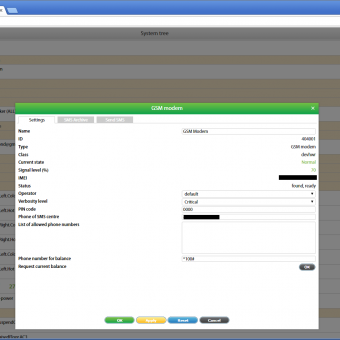

In the system from Vutlan, it is possible to create graphics cards and place sensors on it. It is possible to combine sensors into groups, and work with a group of sensors as with separate sensors.
findings
Unfortunately, there are no technically perfect solutions. In each case, there are convenient solutions and there are uncomfortable for this particular case. If you are designing a project from scratch, and you have an unlimited budget, it is a good choice to focus on the APC infrastructure: cabinets, power outlets, uninterruptible power supply and monitoring system. Then the standard sensors can be connected to the port on the socket strip:
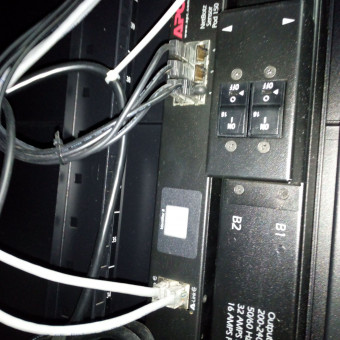

The socket strip and the monitoring module will be installed vertically in the back of the cabinet, without occupying useful and expensive space in the cabinet. Some of the sensors can be connected to an uninterruptible power supply, and on it you can use relay outputs. Sensors, using a proprietary APC plastic clip (worth a few bucks), are very convenient and beautifully attached to the doors of the cabinets:

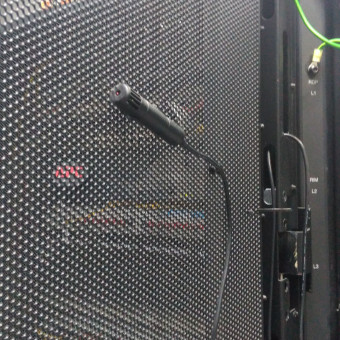

All equipment is automatically recognized by the NMS APC StruxureWare Data Center Expert. But, if you decide to use air conditioners or DGUs from another manufacturer, you will encounter a lot of problems: mismatch of SNMP versions, lack of the required protocol (for example: ACS controllers use their own private protocol to communicate with their server, and ICMP ping over TCP / IPv4. SNMP, as a rule, is not), the lack of templates for the equipment you need, the impossibility of aggregation of graphs and a lot of problems. With a large and homogeneous APC production infrastructure and an unlimited budget, it makes sense to pay attention to the monitoring system, but if you want to save money and buy cabinets from another manufacturer, then know that the plastic retainers do not hold in the doors of the cabinets - drop out, which means aesthetic beauty will be gone. The solution from Vutlan is more convenient for small objects (up to 10-20 sensors), and much cheaper for large objects (from 50 sensors). For small objects, the NMS, the monitoring module built into the web interface, is very convenient. In small volumes and at the initial stage it is quite enough. With the increase in the number of equipment and the number of sensors, or specific requirements - will have to choose an external NMS system. There is a possibility through HTTP post requests or API. Access the integrated monitoring system in the Vutlan monitoring module. At the time of purchase of equipment API was open, now all references to the API and http post requests from the documentation is cut. A new product line with an open API is planned. In the presence of equipment from different manufacturers, its monitoring is more convenient to implement through a solution from Vutlan. It is more flexible both in the software part (it has great capabilities) and in the equipment room - a greater number of sensors. Fun fact: the first temperature sensors that came to the Vutlan SC8100 monitoring module were bundled with 6P4C beige cords. Imagine a black monitoring module, a black patch panel, a black telecommunications cabinet and beige sensors with beige wires. New temperature sensors are equipped with black patch cables, but the sensors themselves are still beige. I hope that this is not a random, thoughtless purchase, but the development of the system in the right direction.

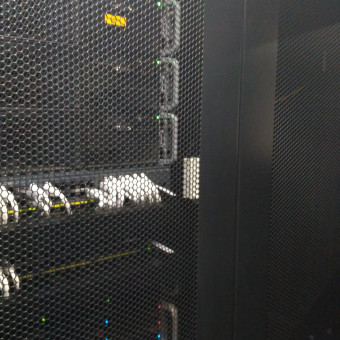
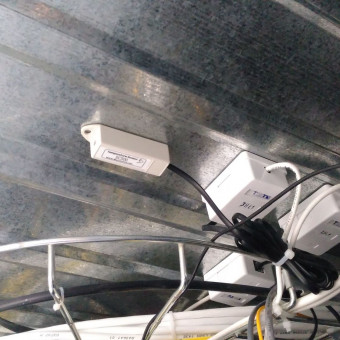
Modules of additional analog sensors (VT408) cannot be fixed to a standard 19 ”1U. We have to put a shelf and place a module on it. It looks - not organic, but from the positive - a shelf under patch cords, fasteners and other trifles appears in your closet. The company Zyxel in the two thousandth years produced the chassis for the DSLAM Zyxel IES-1000 , in which it was possible to install different modules. I hope the manufacturer will do all the same, as promised in the next version of this module, the chassis for the VT408 modules, with a single common power, one CAN port and the ability to install additional contacts modules.
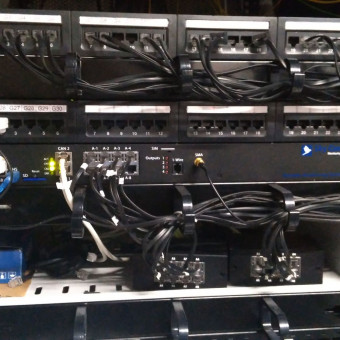
If you do not take into account these features, then the solution from Vutlan is stable, does not cause problems, has a “live” forum. There are firmware fixes current problems. The cost of equipment and the cost of ownership of the system compared to the APC solution is not high. The built-in NMS in the monitoring module is suitable for the role of a backup (second) main NMS system. The ability to integrate data into the NMS system via the SNMP protocol allows you to embed sensor readings into your monitoring system. For the 2015-2016 year, Vutlan significantly expanded the line of modules: the module VT8101, VT300 and others appeared. Now, knowing the need and the number of required temperature, humidity, leakage sensors, the number of dry contact terminals or relays, equipment can be selected so that the “port price” will be significantly lower than that of APC. At the same time, the functionality of monitoring systems is sufficient in both solutions.
Comparison will hold in 3 categories:
- Specifications and Scalability / Expansion
- System features
- Price
In the first case, consider the main differences in the characteristics. We will only compare the parameters, differences in which affect the ease of installation or operation of the system. In the same paragraph, we consider the possibility of scaling the system: the number of ports for sensors in both monitoring systems, the differences and the variety of sensors. In the second case, we consider the software capabilities of the parameters monitoring systems. Collecting information from sensors is a third of the task. The main thing is to notify the staff when the parameters go beyond the limits of the norm, and ideally - to predict the dynamics of changes in parameters, and not to allow the parameters to go beyond the limits of the norm. In the third case, we compare prices for a typical set of modules and sensors of monitoring systems.
- Specifications
| Compare characteristic | Vutlan SC8100 | APC NetBotz 200 |
| Nutrition | AC 220 V, DC 12 V to connect a backup battery | AC 220 V. Socket C13 and C14 |
| Power consumption, W | 18 | 51 |
| Installation | 19 ”, 1U. Horizontal installation. | 19 ”, 1U. In APC cabinets it is possible to mount vertically on the back of the cabinet by analogy with the PDU. |
| Sensor connectors | 6P4C (RJ-11) with non-standard crimp | 8P8C (RJ-45) |
| Maximum number of sensors (without expansion modules) | eight | 6 |
| Maximum number of sensors (including expansion modules) | 100 | |
| Maximum line length to the sensor, meters | 50-150. Depending on the type of sensor | 100 |
| Relay outputs (without expansion modules), pcs | four | one |
| Dry contacts (without expansion modules), pcs. | 0 | one |
| Optional dry contact module | SC16, 16 pcs. Rear mounting in SC8100 | NetBotz RackSensor Pod 150. 6 universal sensors. Rack mounting (horizontal / vertical) |
| Additional sensor module | VT408, 8 analog sensors. Rack mounting is not convenient | NetBotz RackSensor Pod 150. 6 universal sensors. Rack mountable (horizontal / vertical) |
| temperature sensor | Yes | Yes |
| Temperature and humidity sensor | Yes | Yes |
| Humidity sensor | Yes | Not |
| Local leakage sensor | Yes | Yes |
| Air flow sensor | Yes | Not |
| Leakage sensor, cord | Yes | Yes |
| Smoke detector | Yes | Not |
| Current sensor, 4-20 mA | Yes | Not |
| Current sensor, up to 100A | Yes | Not |
| ACS (connecting proximity card reader) | Yes | Yes, by the module. |
| Video surveillance (video camera connection) | Yes | Yes |
| GSM module | Yes module | No, GSM appears in Netbotz 500 |
| SNMP | v1 + v2 or v3, there is SNMP Trap | v1 or v3, there is SNMP Trap |
| Tracking arbitrary equipment by SNMP OID | Yes | Not |
| Tracking arbitrary hardware by ICMP ping | Yes | Not |
| Availability of NMS in the Web interface, | It is possible to build and analyze graphs (notifications, thresholds), graphics cards | It is possible to build graphs, notification of threshold values exceeding |
And now some text and pictures.


I will immediately answer the question why I am paying such attention to installation, sensors and connectors. Almost always, the sensors are removed from the monitoring system at a distance greater than the length of the standard patch cord from the kit. In the diagram, a temperature sensor is connected to the A1 Vutlan SC8100 port, which is located in the same rack. But all the other sensors (ports A2-A6) are located in the next room.

For this, we had to use a standard patch panel, and inexpensive office boxes for cable termination. When connecting the APC Netbotz Rack Monitor 200 to the patch panels, the most common RJ-45 patch cords (1 pc) are used. And the sensors are simply included in the office box. In the case of the Vutlan monitoring system sensors, you will have to worry about finding a rare and non-standard patch cord: 6P4C with direct crimp.

Externally, it looks like a four-wire RJ-11 cable for connecting a telephone device. But the standard cable has a cross-crimp, and the cable for connecting the sensors is straight, because of this, using a standard RJ-11 cable to connect the sensor will not work. And you need to “strongly in advance” to order the right ones, or by purchasing the 6P6C connectors to crimp the cables yourself. Dry contact modules in monitoring systems are implemented in a different way. In the Vutlan system, dry contacts are installed in the system with a separate module, with PCB connectors.

In the APC system, dry contacts are represented by a sensor plugged into a standard port.

With a small amount (1-2) of the output of dry contacts, the solutions are equivalent, with a large number of dry contacts, the monitoring system from Vutlan wins. An important, and maybe for someone, decisive selection criterion will be the variety of sensors connected to the parameter monitoring system. The monitoring system from Vutlan has a wider choice of sensors: analog sensors , digital sensors , current and voltage sensors and a whole section “ accessories ”. A good example is the VT491 bulk temperature sensor or the VT11 controlled dry contact sensor. You will not find such sensors in the APC Netbotz range. But, are they really necessary, because the VT11 is easily replaced by a relay output, and the room temperature is considered to be CDEF functions? Mankind, for two thousand years, has invented a huge number of sensors: pressure, movement, acidity, density - in general, any physical quantities. And, using a 4-20 mA current sensor or a dc voltage sensor, you can integrate any third-party analog sensor into a monitoring system. Using dry contacts and relays, you can integrate any discrete sensor.
- System features
Both the one and the second module of the monitoring system perform their main function: the aggregation of sensor readings, and the display of values using the Web or SNMP protocol:


Both in one and in the second module there is an opportunity to set the limits of values, and a notification about the values leaving the limits of the norm:


All additional, not basic functions are present in both monitoring systems: ftp backup, RADUIS authentication, ntp client, syslog client, sensor graphics:


For the curious, screenshots of the APC Netbotz Rack Monitor 200 and vutlan SC8100 web interfaces can be viewed here.


































At http://www.telemetry.asia/ there is a demo access to the VT2100 username guest, password guest. Although the monitoring system model is different, I did not find any differences in the Web interface. The main difference of these monitoring modules lies in the greater functionality of the embedded NMS system in the monitoring module from Vutlan. For any sensor or received value, you can set any CDEF formula for processing this value (increase / decrease 10 times, transfer seconds to hours / days, decrease / increase by some constant, etc.) Also set alarm and warning values. When you exit the normal boundaries of any monitored parameter, the system will respond by sending a letter to an e-mail, SMS message (if there is a GSM module) or work according to a predefined logic circuit (closes the output relay contacts, turning on the siren and the red flashing beacon):


In the system from Vutlan, it is possible to create graphics cards and place sensors on it. It is possible to combine sensors into groups, and work with a group of sensors as with separate sensors.
- Price
| Vutlan SC8100 | APC NetBotz 200 | |
| Monitoring module Vutlan SC8100, 8 ports and APC NetBotz Rack Monitor 200, 6 ports. | $ 490 | $ 377 |
| Optional Sensor Module (VT408, 8 ports, and RackSensor Pod 150, 6 ports) | $ 150 | $ 240 |
| Additional port for sensors, including VT408 for Vutlan or APC NetBotz RackSensor Pod 150 | $ 19 | $ 40 |
| The cost of 1 port “dry contacts” (excluding the price of the additional port, “sensor only”). | $ 4 | $ 33 |
| temperature sensor | $ 21 | $ 78 |
| Temperature and humidity sensor | $ 81 | $ 118 |
| Humidity sensor | $ 38 | |
| Local leakage sensor | $ 32 | $ 120 |
| Air flow sensor | $ 21 | |
| Leakage sensor, cord | $ 28 | $ 220 |
| Smoke detector | $ 41 | $ 170 |
| Current sensor, 4-20 mA | $ 48 | $ 530 |
findings
Unfortunately, there are no technically perfect solutions. In each case, there are convenient solutions and there are uncomfortable for this particular case. If you are designing a project from scratch, and you have an unlimited budget, it is a good choice to focus on the APC infrastructure: cabinets, power outlets, uninterruptible power supply and monitoring system. Then the standard sensors can be connected to the port on the socket strip:


The socket strip and the monitoring module will be installed vertically in the back of the cabinet, without occupying useful and expensive space in the cabinet. Some of the sensors can be connected to an uninterruptible power supply, and on it you can use relay outputs. Sensors, using a proprietary APC plastic clip (worth a few bucks), are very convenient and beautifully attached to the doors of the cabinets:



All equipment is automatically recognized by the NMS APC StruxureWare Data Center Expert. But, if you decide to use air conditioners or DGUs from another manufacturer, you will encounter a lot of problems: mismatch of SNMP versions, lack of the required protocol (for example: ACS controllers use their own private protocol to communicate with their server, and ICMP ping over TCP / IPv4. SNMP, as a rule, is not), the lack of templates for the equipment you need, the impossibility of aggregation of graphs and a lot of problems. With a large and homogeneous APC production infrastructure and an unlimited budget, it makes sense to pay attention to the monitoring system, but if you want to save money and buy cabinets from another manufacturer, then know that the plastic retainers do not hold in the doors of the cabinets - drop out, which means aesthetic beauty will be gone. The solution from Vutlan is more convenient for small objects (up to 10-20 sensors), and much cheaper for large objects (from 50 sensors). For small objects, the NMS, the monitoring module built into the web interface, is very convenient. In small volumes and at the initial stage it is quite enough. With the increase in the number of equipment and the number of sensors, or specific requirements - will have to choose an external NMS system. There is a possibility through HTTP post requests or API. Access the integrated monitoring system in the Vutlan monitoring module. At the time of purchase of equipment API was open, now all references to the API and http post requests from the documentation is cut. A new product line with an open API is planned. In the presence of equipment from different manufacturers, its monitoring is more convenient to implement through a solution from Vutlan. It is more flexible both in the software part (it has great capabilities) and in the equipment room - a greater number of sensors. Fun fact: the first temperature sensors that came to the Vutlan SC8100 monitoring module were bundled with 6P4C beige cords. Imagine a black monitoring module, a black patch panel, a black telecommunications cabinet and beige sensors with beige wires. New temperature sensors are equipped with black patch cables, but the sensors themselves are still beige. I hope that this is not a random, thoughtless purchase, but the development of the system in the right direction.



Modules of additional analog sensors (VT408) cannot be fixed to a standard 19 ”1U. We have to put a shelf and place a module on it. It looks - not organic, but from the positive - a shelf under patch cords, fasteners and other trifles appears in your closet. The company Zyxel in the two thousandth years produced the chassis for the DSLAM Zyxel IES-1000 , in which it was possible to install different modules. I hope the manufacturer will do all the same, as promised in the next version of this module, the chassis for the VT408 modules, with a single common power, one CAN port and the ability to install additional contacts modules.

If you do not take into account these features, then the solution from Vutlan is stable, does not cause problems, has a “live” forum. There are firmware fixes current problems. The cost of equipment and the cost of ownership of the system compared to the APC solution is not high. The built-in NMS in the monitoring module is suitable for the role of a backup (second) main NMS system. The ability to integrate data into the NMS system via the SNMP protocol allows you to embed sensor readings into your monitoring system. For the 2015-2016 year, Vutlan significantly expanded the line of modules: the module VT8101, VT300 and others appeared. Now, knowing the need and the number of required temperature, humidity, leakage sensors, the number of dry contact terminals or relays, equipment can be selected so that the “port price” will be significantly lower than that of APC. At the same time, the functionality of monitoring systems is sufficient in both solutions.
')
Source: https://habr.com/ru/post/301912/
All Articles